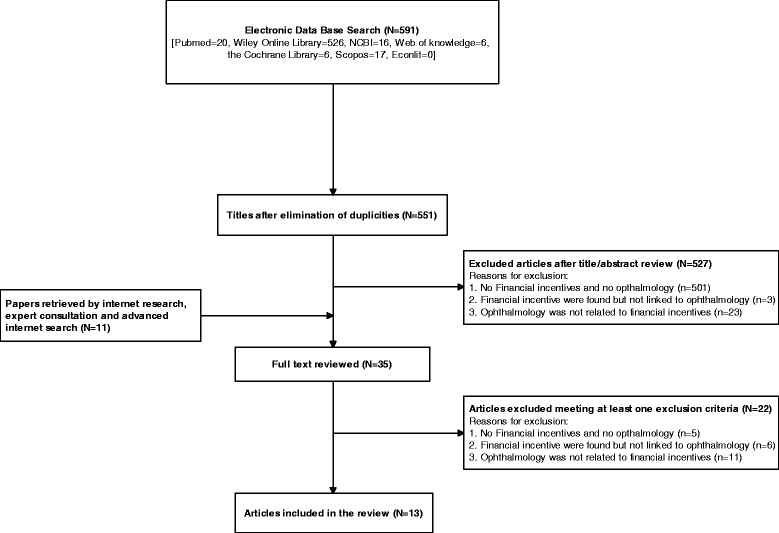Characterization and effectiveness of pay-for-performance in ophthalmology: a systematic review
- PMID: 28583141
- PMCID: PMC5460462
- DOI: 10.1186/s12913-017-2333-x
Characterization and effectiveness of pay-for-performance in ophthalmology: a systematic review
Abstract
Background: To identify, characterize and compare existing pay-for-performance approaches and their impact on the quality of care and efficiency in ophthalmology.
Methods: A systematic evidence-based review was conducted. English, French and German written literature published between 2000 and 2015 were searched in the following databases: Medline (via PubMed), NCBI web site, Scopus, Web of Knowledge, Econlit and the Cochrane Library. Empirical as well as descriptive articles were included. Controlled clinical trials, meta-analyses, randomized controlled studies as well as observational studies were included as empirical articles. Systematic characterization of identified pay-for-performance approaches (P4P approaches) was conducted according to the "Model for Implementing and Monitoring Incentives for Quality" (MIMIQ). Methodological quality of empirical articles was assessed according to the Critical Appraisal Skills Programme (CASP) checklists.
Results: Overall, 13 relevant articles were included. Eleven articles were descriptive and two articles included empirical analyses. Based on these articles, four different pay-for-performance approaches implemented in the United States were identified. With regard to quality and incentive elements, systematic comparison showed numerous differences between P4P approaches. Empirical studies showed isolated cost or quality effects, while a simultaneous examination of these effects was missing.
Conclusion: Research results show that experiences with pay-for-performance approaches in ophthalmology are limited. Identified approaches differ with regard to quality and incentive elements restricting comparability. Two empirical studies are insufficient to draw strong conclusions about the effectiveness and efficiency of these approaches.
Keywords: Ophthalmology; P4P; Pay for performance; Systematic comparison.
Figures
Similar articles
-
Payment methods for outpatient care facilities.Cochrane Database Syst Rev. 2017 Mar 3;3(3):CD011153. doi: 10.1002/14651858.CD011153.pub2. Cochrane Database Syst Rev. 2017. PMID: 28253540 Free PMC article.
-
Systemic pharmacological treatments for chronic plaque psoriasis: a network meta-analysis.Cochrane Database Syst Rev. 2021 Apr 19;4(4):CD011535. doi: 10.1002/14651858.CD011535.pub4. Cochrane Database Syst Rev. 2021. Update in: Cochrane Database Syst Rev. 2022 May 23;5:CD011535. doi: 10.1002/14651858.CD011535.pub5. PMID: 33871055 Free PMC article. Updated.
-
Surveillance of Barrett's oesophagus: exploring the uncertainty through systematic review, expert workshop and economic modelling.Health Technol Assess. 2006 Mar;10(8):1-142, iii-iv. doi: 10.3310/hta10080. Health Technol Assess. 2006. PMID: 16545207
-
Intravenous magnesium sulphate and sotalol for prevention of atrial fibrillation after coronary artery bypass surgery: a systematic review and economic evaluation.Health Technol Assess. 2008 Jun;12(28):iii-iv, ix-95. doi: 10.3310/hta12280. Health Technol Assess. 2008. PMID: 18547499
-
A rapid and systematic review of the clinical effectiveness and cost-effectiveness of topotecan for ovarian cancer.Health Technol Assess. 2001;5(28):1-110. doi: 10.3310/hta5280. Health Technol Assess. 2001. PMID: 11701100
Cited by
-
Impact of reimbursement systems on patient care - a systematic review of systematic reviews.Health Econ Rev. 2024 Mar 16;14(1):22. doi: 10.1186/s13561-024-00487-6. Health Econ Rev. 2024. PMID: 38492098 Free PMC article. Review.
-
Factors associated with the workload of health professionals in hospital at home: a systematic review.BMC Health Serv Res. 2022 May 26;22(1):704. doi: 10.1186/s12913-022-08100-4. BMC Health Serv Res. 2022. PMID: 35619075 Free PMC article.
References
-
- Wendt C. Mapping European healthcare systems: a comparative analysis of financing, service provision and access to healthcare. J Eur Soc Policy. 2009;19:432–445. doi: 10.1177/0958928709344247. - DOI
-
- Wendt C, Frisina L, Rothgang H. Healthcare System Types: A Conceptual Framework for Comparison. Soc Policy Adm. 2009;43:70–90. doi: 10.1111/j.1467-9515.2008.00647.x. - DOI
Publication types
MeSH terms
LinkOut - more resources
Full Text Sources
Other Literature Sources


